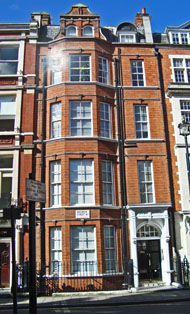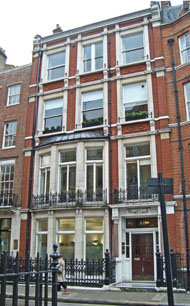McCaul Hospital for Officers
51-52 Welbeck Street, W1M 7HE
Medical dates:
Medical character:
Convalescent (military)
At the turn of the 20th century Miss
Ethel McCaul (1867-1931), a Royal Red Cross
nurse and a well known
figure in the London nursing world, established a private nursing home
at 51 Welbeck Street. It had 15 beds, an operating theatre and a
staff of 20, half of them nurses. It was here that Sir Frederick
Treves (1853-1923) operated on King Edward VII for appendicitis on the
eve of his Coronation in 1902. (A metal plate with the King's
signature commemorating the
event was later attached to the operating table. The Coronation,
originally scheduled for 26th June, finally took place on 9th August.)
At the outbreak of WW1 in 1914 Miss McCaul made the nursing home available to the War Office for use as a military hospital.
The McCaul Hospital for Officers (at some stage the house next door, No. 52, had also been taken over) had 46 beds and was affiliated to Queen Alexandra's Military Hospital.
In 1917 Mr Howard Kemp Prosser, a colour specialist and interior designer, redesigned the colour scheme for one of the wards for shell-shocked officers. Mr Kemp Prosser, who had studied 'colour medicine', was convinced of the therapeutic value of colour and was willing to design, free of charge, a 'Colour Ward' in any military hospital.
The 'Colour Ward' was painted in the tones of early spring, with the walls in sunshine yellow, the ceiling in firmament blue and the woodwork in spring green. The furniture was painted primrose yellow, with the idea that it would blend into the walls. The floor, in primrose green, was intended to harmonise with the walls, furniture and ceiling. The idea behind such a scheme was that the patient would have a sense of space, and not be conscious of confinement between four walls. Any autumn tints, denoting death and decay, were avoided.
The curtains, on separately swung rails, were of yellow or mauve, so that a patient who needed a yellow light or a violet light could choose to have that curtain drawn towards him. The couch was in a mauve colour with reversible cushions - primrose yellow on one side for dull days and mauve on the other for too bright days. The bed screens were in a blue colour.
The fire stove, hearth and fender were of dull silver, which was washable. Pale blue delphiniums were placed in delicate yellow vases on the mantelpiece, beside a small painting of a spring scene.
Meals were served on primrose yellow crockery and carried to the patients on dull silver trays.
The 'Colour Ward' proved a success and, in 1918, such a ward was established in Section IV of the Maudsley Neurological Clearing Hospital at Denmark Hill, where shell-shocked cases were treated.
The Hospital closed presumably in 1919.
Present status (April 2010)
Both 5-storey buildings are now used as offices.
At the outbreak of WW1 in 1914 Miss McCaul made the nursing home available to the War Office for use as a military hospital.
The McCaul Hospital for Officers (at some stage the house next door, No. 52, had also been taken over) had 46 beds and was affiliated to Queen Alexandra's Military Hospital.
In 1917 Mr Howard Kemp Prosser, a colour specialist and interior designer, redesigned the colour scheme for one of the wards for shell-shocked officers. Mr Kemp Prosser, who had studied 'colour medicine', was convinced of the therapeutic value of colour and was willing to design, free of charge, a 'Colour Ward' in any military hospital.
The 'Colour Ward' was painted in the tones of early spring, with the walls in sunshine yellow, the ceiling in firmament blue and the woodwork in spring green. The furniture was painted primrose yellow, with the idea that it would blend into the walls. The floor, in primrose green, was intended to harmonise with the walls, furniture and ceiling. The idea behind such a scheme was that the patient would have a sense of space, and not be conscious of confinement between four walls. Any autumn tints, denoting death and decay, were avoided.
The curtains, on separately swung rails, were of yellow or mauve, so that a patient who needed a yellow light or a violet light could choose to have that curtain drawn towards him. The couch was in a mauve colour with reversible cushions - primrose yellow on one side for dull days and mauve on the other for too bright days. The bed screens were in a blue colour.
The fire stove, hearth and fender were of dull silver, which was washable. Pale blue delphiniums were placed in delicate yellow vases on the mantelpiece, beside a small painting of a spring scene.
Meals were served on primrose yellow crockery and carried to the patients on dull silver trays.
The 'Colour Ward' proved a success and, in 1918, such a ward was established in Section IV of the Maudsley Neurological Clearing Hospital at Denmark Hill, where shell-shocked cases were treated.
The Hospital closed presumably in 1919.
|
No further details, as yet, have come to light about this Hospital or the Nursing Home.
If you have further information, please contact:
webmaster@ezitis.myzen.co.uk |
Present status (April 2010)
Both 5-storey buildings are now used as offices.

No. 51 Welbeck Street, site of the original Nursing Home.


No. 52 Welbeck Street (Ashton House).
(Author unstated) 1917 List of the various hospitals treating miltary cases in the United Kingdom. London, H.M.S.O.
(Author unstated) 1917 Sunshine for shell shock. British Journal of Nursing, 6th October, 224.
(Author unstated) 1918 The influence of colour. British Journal of Nursing, 19th September, 153.
(Author unstated) 1931 The Passing Bell. Miss Ethel McCaul, R.R.C. British Journal of Nursing (December), 339.
Carrington H 1920 Psychical Phenomena and the War. New York, American Universities Publishing Co.
www.allposters.com
www.angloboerwar.com
www.art.co.uk
www.btinternet.com
www.flightglobal.com (1)
www.flightglobal.com (2)
www.kentvad.org
www.museumstuff.com
www.paperspast.natlib.govt.nz (1)
www.paperspast.natlib.govt.nz (2)
www.samtiden.no
Return to home page